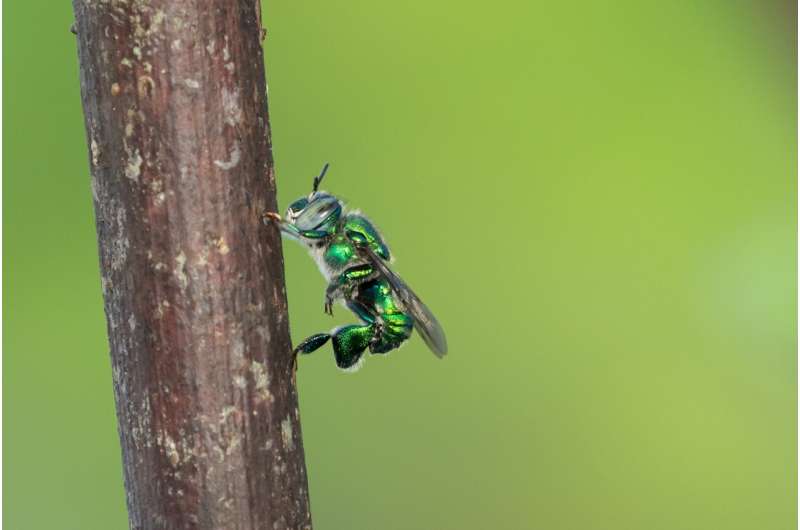This article has been reviewed according to Science X's editorial process and policies. Editors have highlighted the following attributes while ensuring the content's credibility:
fact-checked
peer-reviewed publication
trusted source
proofread
Why orchid bees concoct their own fragrance

Male bees display a remarkable passion for collecting scents: they deposit scents from various sources in special pockets on their hind legs, thus composing their own fragrance. This behavior has been known since the 1960s. The reason why they do it has been the subject of much speculation.
Researchers from Ruhr University Bochum, Germany, in collaboration with colleagues from the University of California at Davis and the University of Florida at Fort Lauderdale, have finally solved the mystery. The bee fragrance serves as a sex attractant and increases the reproductive success of the males, as the team found out after three years of experiments in flight cages.
The group headed by Ph.D. student Jonas Henske and Dr. Thomas Eltz from the Bochum Department of Animal Ecology, Evolution and Biodiversity describes their findings in the journal Current Biology, published online on April 12, 2023.
There's been a lot of theorizing about the purpose of the fragrance: some have suggested that it could be an attractant or a wedding gift for the females, or that the scent is used to communicate with rivals. In a previous paper, the group around Thomas Eltz had already shown that the male bees transport the fragrance out of the pockets on their hind legs during the courtship ritual. "What we didn't know, however, was who was supposed to receive this signal," says Eltz. "The females? Or rival males?"
The researchers pursued this question in the current project. For three years, they studied orchid bees in an experiment in Florida. In a 15 by 15 by 4 meter cage, they had two male bees each compete for a female—one with fragrance and one without. They then tracked whether the female mated and, if so, with which male.
Mating activities difficult to observe
"The mating of orchid bees is very rarely observed in the wild, and even in experiments it's been almost impossible to get them to mate," says Thomas Eltz. This is why the Bochum-based researchers and their U.S. colleagues tried to offer the bees optimal conditions; for example, they used a particularly large cage and provided the animals with the perfect pollen plants.
For the experiment, the researchers first lured male bees to artificial scent sources, which the bees then used to create a fragrance. The scientists extracted this fragrance from the pockets on the hind legs using a microcapillary and subsequently transferred it to one of the bees that they tested in the experiment. Here, two males, which had been kept under identical conditions, competed for the favor of females.
Typical courtship behavior with varying degrees of success
The males—with or without fragrance—displayed typical courtship behavior. Mating occurred with 27 females, which each mated with a single mate. Male bees that had been equipped with fragrance were involved in 26 of these cases. In one case, a male reproduced that belonged to the control group, which should have been fragrance-free; however, the researchers found hints that this individual had also acquired a scent mixture—fragrance theft does occasionally occur.
In order to be able to prove beyond doubt which males had mated, Jonas Henske carried out paternity analyses. He compared the genetic make-up of the brood with that of the male bees.
"It's become clear that the fragrance is an attractant for females and triggers mating behavior in them," says Thomas Eltz. "Our results also prove that the fragrance is probably not used as a status signal among males. Indeed, a male was not more likely to defend his courtship site when he was in possession of fragrance."
About orchid bees
There are about 250 known species of euglossine bees that are important pollinators in the tropics of Central and South America. Many orchid species rely on male euglossine bees for pollination, which is why these insects are commonly known as orchid bees. These orchids produce specific flower scents as a reward, which are collected by the male bees.
here are five different genera of orchid bees, and they can vary greatly in size and appearance. The male bees collect the scents with tufts of hair on their front legs, which they wring out into the pockets on their hind legs.
More information: Jonas Henske et al, Function of environment-derived male perfumes in orchid bees, Current Biology (2023). DOI: 10.1016/j.cub.2023.03.060
Journal information: Current Biology
Provided by Ruhr-Universitaet-Bochum

















